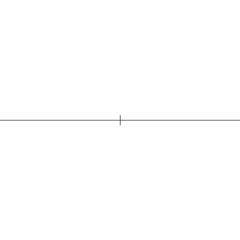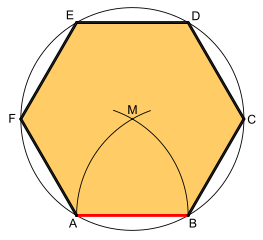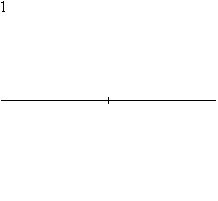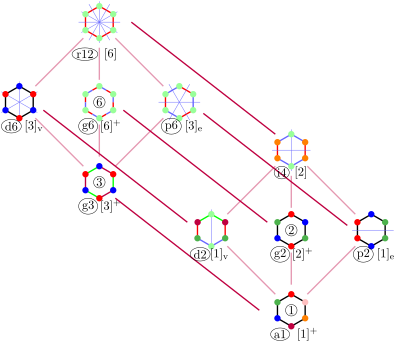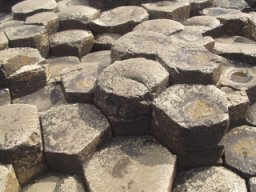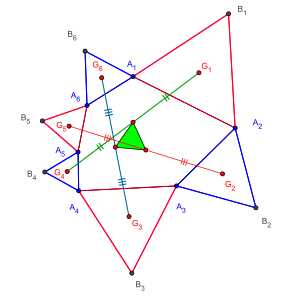سداسي
| Regular hexagon | |
|---|---|
 A regular hexagon | |
| النوع | مضلع منتظم |
| الأضلاع والرؤوس | {{{p6 جانب}}} |
| رمز شلفلي | {{{p6-شلفلي}}} |
| مخططات كوكستر-دنكن | |
| مجموعة التماثل | Dihedral (D6), order 2×6 |
| الزاوية الداخلية (الدرجات) | 120° |
| الخصائص | Convex, cyclic, equilateral, isogonal, isotoxal |
السداسي هو مضلع مكون من ستة أضلاع وستة زوايا. وتتقابل أضلاع السداسي، في نقاط تُسمى الرؤوس مكونة ست زوايا داخلية. ومجموع الزوايا الداخلية للسداسي هو دائمًا 720°. ويقال إن السداسي منتظم، إذا كانت جميع الأضلاع والزوايا متساوية. وتبلغ كل زاوية من زوايا السداسي المنتظم 120°. وتساوي مساحة السداسي المنتظم، نصف حاصل ضرب محيطه في عامده، وهو المسافة من مركز مضلع منتظم إلى منتصف أحد أضلاعه.[1]
السداسي المنتظم
A regular hexagon has Schläfli symbol {6}[2] and can also be constructed as a truncated equilateral triangle, t{3}, which alternates two types of edges.
A regular hexagon is defined as a hexagon that is both equilateral and equiangular. It is bicentric, meaning that it is both cyclic (has a circumscribed circle) and tangential (has an inscribed circle).
The common length of the sides equals the radius of the circumscribed circle or circumcircle, which equals times the apothem (radius of the inscribed circle). All internal angles are 120 degrees. A regular hexagon has six rotational symmetries (rotational symmetry of order six) and six reflection symmetries (six lines of symmetry), making up the dihedral group D6. The longest diagonals of a regular hexagon, connecting diametrically opposite vertices, are twice the length of one side. From this it can be seen that a triangle with a vertex at the center of the regular hexagon and sharing one side with the hexagon is equilateral, and that the regular hexagon can be partitioned into six equilateral triangles.
Like squares and equilateral triangles, regular hexagons fit together without any gaps to tile the plane (three hexagons meeting at every vertex), and so are useful for constructing tessellations. The cells of a beehive honeycomb are hexagonal for this reason and because the shape makes efficient use of space and building materials. The Voronoi diagram of a regular triangular lattice is the honeycomb tessellation of hexagons. It is not usually considered a triambus, although it is equilateral.
- في الشكل السداسي المنتظم (مسدس) تبلغ قيمة الزاوية الداخلية لكل ضلعين متجاورين 120 درجة، ومجموع زواياه 720 درجة.
المتغيرات
The maximal diameter (which corresponds to the long diagonal of the hexagon), D, is twice the maximal radius or circumradius, R, which equals the side length, t. The minimal diameter or the diameter of the inscribed circle (separation of parallel sides, flat-to-flat distance, short diagonal or height when resting on a flat base), d, is twice the minimal radius or inradius, r. The maxima and minima are related by the same factor:
- and, similarly,
The area of a regular hexagon
For any regular polygon, the area can also be expressed in terms of the apothem a and the perimeter p. For the regular hexagon these are given by a = r, and p, so
The regular hexagon fills the fraction of its circumscribed circle.
If a regular hexagon has successive vertices A, B, C, D, E, F and if P is any point on the circumcircle between B and C, then PE + PF = PA + PB + PC + PD.
It follows from the ratio of circumradius to inradius that the height-to-width ratio of a regular hexagon is 1:1.1547005; that is, a hexagon with a long diagonal of 1.0000000 will have a distance of 0.8660254 between parallel sides.
التماثل

The regular hexagon has Dih6 symmetry, order 12. There are 3 dihedral subgroups: Dih3, Dih2, and Dih1, and 4 cyclic subgroups: Z6, Z3, Z2, and Z1.
These symmetries express 9 distinct symmetries of a regular hexagon. John Conway labels these by a letter and group order.[3] r12 is full symmetry, and a1 is no symmetry. p6, an isogonal hexagon constructed by three mirrors can alternate long and short edges, and d6, an isotoxal hexagon constructed with equal edge lengths, but vertices alternating two different internal angles. These two forms are duals of each other and have half the symmetry order of the regular hexagon. The i4 forms are regular hexagons flattened or stretched along one symmetry direction. It can be seen as an elongated rhombus, while d2 and p2 can be seen as horizontally and vertically elongated kites. g2 hexagons, with opposite sides parallel are also called hexagonal parallelogons.
Each subgroup symmetry allows one or more degrees of freedom for irregular forms. Only the g6 subgroup has no degrees of freedom but can seen as directed edges.
| أمثلة مسدسات حسب التماثل | |||||||||||||||||||
|---|---|---|---|---|---|---|---|---|---|---|---|---|---|---|---|---|---|---|---|
|
Hexagons of symmetry g2, i4, and r12, as parallelogons can tessellate the Euclidean plane by translation. Other hexagon shapes can tile the plane with different orientations.
| p6m (*632) | cmm (2*22) | p2 (2222) | p31m (3*3) | pmg (22*) | pg (××) | |
|---|---|---|---|---|---|---|
 r12 |
 i4 |
 g2 |
 d2 |
 d2 |
 p2 |
 a1 |
مجموعات A2 و G2
 A2 group roots |
 G2 group roots |
The 6 roots of the simple Lie group A2, represented by a Dynkin diagram ![]()
![]()
![]() , are in a regular hexagonal pattern. The two simple roots have a 120° angle between them.
, are in a regular hexagonal pattern. The two simple roots have a 120° angle between them.
The 12 roots of the Exceptional Lie group G2, represented by a Dynkin diagram ![]()
![]()
![]() are also in a hexagonal pattern. The two simple roots of two lengths have a 150° angle between them.
are also in a hexagonal pattern. The two simple roots of two lengths have a 150° angle between them.
تشريح
| 6-cube projection | 10 rhomb dissection | |
|---|---|---|

|

|

|
Coxeter states that every zonogon (a 2m-gon whose opposite sides are parallel and of equal length) can be dissected into m(m-1)/2 parallelograms.[4] In particular this is true for regular polygons with evenly many sides, in which case the parallelograms are all rhombi. This decomposition of a regular hexagon is based on a Petrie polygon projection of a cube, with 3 of 6 square faces. Other parallelogons and projective directions of the cube are dissected within rectangular cuboids.
| تشريح مسدسات إلى 3 معيّنات ومتوازيات أضلاع | |||||||||||
|---|---|---|---|---|---|---|---|---|---|---|---|
| 2D | معيّنات | متوازيات أضلاع | |||||||||

|

|

|

| ||||||||
| منتظمة {6} | Hexagonal parallelogons | ||||||||||
| 3D | أوجه مربعة | أوجه مستطيلة | |||||||||

|

|

|

| ||||||||
| مكعب | Rectangular cuboid | ||||||||||
مضلعات وتبليطات متعلقة
A regular hexagon has Schläfli symbol {6}. A regular hexagon is a part of the regular hexagonal tiling, {6,3}, with 3 hexagonal around each vertex.
A regular hexagon can also be created as a truncated equilateral triangle, with Schläfli symbol t{3}. Seen with two types (colors) of edges, this form only has D3 symmetry.
A truncated hexagon, t{6}, is a dodecagon, {12}, alternating 2 types (colors) of edges. An alternated hexagon, h{6}, is a equilateral triangle, {3}. A regular hexagon can be stellated with equilateral triangles on its edges, creating a hexagram. A regular hexagon can be dissected into 6 equilateral triangles by adding a center point. This pattern repeats within the regular triangular tiling.
A regular hexagon can be extended into a regular dodecagon by adding alternating squares and equilateral triangles around it. This pattern repeats within the rhombitrihexagonal tiling.

|

|

|

|

|

|

|

|
| Regular {6} |
Truncated t{3} = {6} |
Hypertruncated triangles | Stellated Star figure 2{3} |
Truncated t{6} = {12} |
Alternated h{6} = {3} | ||
|---|---|---|---|---|---|---|---|

|

|

|

|

|

|
| Crossed hexagon |
A concave hexagon | A self-intersecting hexagon (star polygon) | Dissected {6} | Extended Central {6} in {12} |
A skew hexagon, within cube |
|---|
There are 6 self-crossing hexagons with the vertex arrangement of the regular hexagon:
| Dih2 | Dih1 | Dih3 | |||
|---|---|---|---|---|---|
 Figure-eight |
 Center-flip |
 Unicursal |
 Fish-tail |
 Double-tail |
 Triple-tail |
بنى مسدسية
From bees' honeycombs to the Giant's Causeway, hexagonal patterns are prevalent in nature due to their efficiency. In a hexagonal grid each line is as short as it can possibly be if a large area is to be filled with the fewest hexagons. This means that honeycombs require less wax to construct and gain lots of strength under compression.
Irregular hexagons with parallel opposite edges are called parallelogons and can also tile the plane by translation. In three dimensions, hexagonal prisms with parallel opposite faces are called parallelohedrons and these can tessellate 3-space by translation.
| Form | Hexagonal tiling | Hexagonal prismatic honeycomb |
|---|---|---|
| Regular | 
|

|
| Parallelogonal | 
|

|
Tesselations by hexagons
In addition to the regular hexagon, which determines a unique tessellation of the plane, any irregular hexagon which satisfies the Conway criterion will tile the plane.
مسدس مرسوم في قطع مخروطي
Pascal's theorem (also known as the "Hexagrammum Mysticum Theorem") states that if an arbitrary hexagon is inscribed in any conic section, and pairs of opposite sides are extended until they meet, the three intersection points will lie on a straight line, the "Pascal line" of that configuration.
مسدس دوري
The Lemoine hexagon is a cyclic hexagon (one inscribed in a circle) with vertices given by the six intersections of the edges of a triangle and the three lines that are parallel to the edges that pass through its symmedian point.
If the successive sides of a cyclic hexagon are a, b, c, d, e, f, then the three main diagonals intersect in a single point if and only if ace = bdf.[5]
If, for each side of a cyclic hexagon, the adjacent sides are extended to their intersection, forming a triangle exterior to the given side, then the segments connecting the circumcenters of opposite triangles are concurrent.[6]
If a hexagon has vertices on the circumcircle of an acute triangle at the six points (including three triangle vertices) where the extended altitudes of the triangle meet the circumcircle, then the area of the hexagon is twice the area of the triangle.[7]
مسدس مماس لقطع مخروطي
Let ABCDEF be a hexagon formed by six tangent lines of a conic section. Then Brianchon's theorem states that the three main diagonals AD, BE, and CF intersect at a single point.
In a hexagon that is tangential to a circle and that has consecutive sides a, b, c, d, e, and f,[8]
مثلثات متساوية الأضلاع على جوانب مسدس عشوائي
If an equilateral triangle is constructed externally on each side of any hexagon, then the midpoints of the segments connecting the centroids of opposite triangles form another equilateral triangle.[9]
المسدس المنحرف
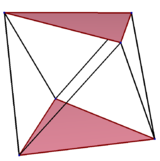
A skew hexagon is a skew polygon with 6 vertices and edges but not existing on the same plane. The interior of such an hexagon is not generally defined. A skew zig-zag hexagon has vertices alternating between two parallel planes.
A regular skew hexagon is vertex-transitive with equal edge lengths. In 3-dimensions it will be a zig-zag skew hexagon and can be seen in the vertices and side edges of a triangular antiprism with the same D3d, [2+,6] symmetry, order 12.
The cube and octahedron (same as triangular antiprism) have regular skew hexagons as petrie polygons.
 Cube |
 Octahedron |
مضلعات پتري
The regular skew hexagon is the Petrie polygon for these higher dimensional regular, uniform and dual polyhedra and polytopes, shown in these skew orthogonal projections:
| 4D | 5D | |
|---|---|---|
 3-3 duoprism |
 3-3 duopyramid |
 5-simplex |
مسدس متساوي الأضلاح مقعر
A principal diagonal of a hexagon is a diagonal which divides the hexagon into quadrilaterals. In any convex equilateral hexagon (one with all sides equal) with common side a, there exists[10] a principal diagonal d1 such that
and a principal diagonal d2 such that
متعددات الأوجه بمسدسات
There is no Platonic solid made of only regular hexagons, because the hexagons tessellate, not allowing the result to "fold up". The Archimedean solids with some hexagonal faces are the truncated tetrahedron, truncated octahedron, truncated icosahedron (of soccer ball and fullerene fame), truncated cuboctahedron and the truncated icosidodecahedron. These hexagons can be considered truncated triangles, with Coxeter diagrams of the form ![]()
![]()
![]()
![]()
![]() and
and ![]()
![]()
![]()
![]()
![]() .
.
| مسدسات في جواسئ أرخميدية | |||||||||||
|---|---|---|---|---|---|---|---|---|---|---|---|
| رباعي الأوجه | ثماني الأوجه | Icosahedral | |||||||||
 truncated tetrahedron |
 truncated octahedron |
 truncated cuboctahedron |
 truncated icosahedron |
 truncated icosidodecahedron | |||||||
توجد متعددات أوجه تماثلية أخرى بمسدسات ممطوطة أو مفلطحة، مثل تلك متعدد أوجه گولدبرگ G(2,0):
| مسدسات في متعددات أوجه گولدبرگ | |||||||||||
|---|---|---|---|---|---|---|---|---|---|---|---|
| Tetrahedral | Octahedral | Icosahedral | |||||||||
 Chamfered tetrahedron |
 Chamfered cube |
 Chamfered dodecahedron | |||||||||
There are also 9 Johnson solids with regular hexagons:
| Prismoids بمسدسات | |||||||||||
|---|---|---|---|---|---|---|---|---|---|---|---|
 Hexagonal prism |
 Hexagonal antiprism |
 Hexagonal pyramid | |||||||||
| تبليطات بمسدسات منتظمة | |||||||||||
|---|---|---|---|---|---|---|---|---|---|---|---|
| منتظم | 1-uniform | ||||||||||
| {6,3} |
r{6,3} |
rr{6,3} |
tr{6,3} | ||||||||

|

|

|

| ||||||||
| 2-uniform tilings | |||||||||||
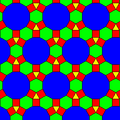
|

|

|

| ||||||||
معرض المسدسات الطبيعية والاصطناعية
The ideal crystalline structure of graphene is a hexagonal grid.
Assembled E-ELT mirror segments
A beehive honeycomb
The scutes of a turtle's carapace
Saturn's hexagon, a hexagonal cloud pattern around the north pole of the planet
Benzene, the simplest aromatic compound with hexagonal shape.
Crystal structure of a molecular hexagon composed of hexagonal aromatic rings.
Naturally formed basalt columns from Giant's Causeway in Northern Ireland; large masses must cool slowly to form a polygonal fracture pattern
An aerial view of Fort Jefferson in Dry Tortugas National Park
The James Webb Space Telescope mirror is composed of 18 hexagonal segments.
Metropolitan France has a vaguely hexagonal shape. In French, l'Hexagone refers to the European mainland of France.
Hexagonal Hanksite crystal, one of many hexagonal crystal system minerals
The Hexagon, a hexagonal theatre in Reading, Berkshire
Władysław Gliński's شطرنج مسدسي
مقصورة في حديقة نباتات تايوان
انظر أيضاً
- 24-cell: a four-dimensional figure which, like the hexagon, has orthoplex facets, is self-dual and tessellates Euclidean space
- Hexagonal crystal system
- Hexagonal number
- Hexagonal tiling: a regular tiling of hexagons in a plane
- Hexagram: 6-sided star within a regular hexagon
- Unicursal hexagram: single path, 6-sided star, within a hexagon
- Honeycomb conjecture
المراجع
- ^ الموسوعة المعرفية الشاملة
- ^ Wenninger, Magnus J. (1974), Polyhedron Models, Cambridge University Press, p. 9, ISBN 9780521098595, https://books.google.com/books?id=N8lX2T-4njIC&pg=PA9, retrieved on 2015-11-06.
- ^ John H. Conway, Heidi Burgiel, Chaim Goodman-Strauss, (2008) The Symmetries of Things, ISBN 978-1-56881-220-5 (Chapter 20, Generalized Schaefli symbols, Types of symmetry of a polygon pp. 275-278)
- ^ Coxeter, Mathematical recreations and Essays, Thirteenth edition, p.141
- ^ Cartensen, Jens, "About hexagons", Mathematical Spectrum 33(2) (2000–2001), 37–40.
- ^ Dergiades, Nikolaos (2014). "Dao's theorem on six circumcenters associated with a cyclic hexagon". Forum Geometricorum. 14: 243–246.
- ^ Johnson, Roger A., Advanced Euclidean Geometry, Dover Publications, 2007 (orig. 1960).
- ^ Gutierrez, Antonio, "Hexagon, Inscribed Circle, Tangent, Semiperimeter", [1], Accessed 2012-04-17.
- ^ Dao Thanh Oai (2015). "Equilateral triangles and Kiepert perspectors in complex numbers". Forum Geometricorum. 15: 105–114.
- ^ Inequalities proposed in “Crux Mathematicorum”, [2].
وصلات خارجية
الوصلات الخارجية في هذه المقالة قد لا تتبع سياسات المحتوى أو الإرشادات. من فضلك حسـِّن هذه المقالة بإزالة الوصلات الخارجية الزائدة أو غير المناسبة. |
- Definition and properties of a hexagon with interactive animation and construction with compass and straightedge.
- An Introduction to Hexagonal Geometry on Hexnet a website devoted to hexagon mathematics.
- Cymatics – Hexagonal shapes occurring within water sound images[dead link]
- Cassini Images Bizarre Hexagon on Saturn
- Saturn's Strange Hexagon
- A hexagonal feature around Saturn's North Pole
- "Bizarre Hexagon Spotted on Saturn" – from Space.com (27 March 2007)
| كثيرات الجوانب المعتادة والمنتظمة المحدبة الأساسية في الأبعاد 2–10 | ||||||||||||
|---|---|---|---|---|---|---|---|---|---|---|---|---|
| العائلة | An | Bn | I2(p) / Dn | E6 / E7 / E8 / F4 / G2 | Hn | |||||||
| مضلع منتظم | مثلث | مربع | p-gon | مسدس | مخمس | |||||||
| متعدد السطوح المنتظم | رباعي الأسطح | Octahedron • مكعب | Demicube | Dodecahedron • Icosahedron | ||||||||
| Uniform 4-polytope | 5-cell | 16-cell • Tesseract | Demitesseract | 24-cell | 120-cell • 600-cell | |||||||
| Uniform 5-polytope | 5-simplex | 5-orthoplex • 5-cube | 5-demicube | |||||||||
| Uniform 6-polytope | 6-simplex | 6-orthoplex • 6-cube | 6-demicube | 122 • 221 | ||||||||
| Uniform 7-polytope | 7-simplex | 7-orthoplex • 7-cube | 7-demicube | 132 • 231 • 321 | ||||||||
| Uniform 8-polytope | 8-simplex | 8-orthoplex • 8-cube | 8-demicube | 142 • 241 • 421 | ||||||||
| Uniform 9-polytope | 9-simplex | 9-orthoplex • 9-cube | 9-demicube | |||||||||
| Uniform 10-polytope | 10-simplex | 10-orthoplex • 10-cube | 10-demicube | |||||||||
| Uniform n-polytope | n-simplex | n-orthoplex • n-cube | n-demicube | 1k2 • 2k1 • k21 | n-pentagonal polytope | |||||||
| المواضيع: Polytope families • Regular polytope • List of regular polytopes and compounds | ||||||||||||
